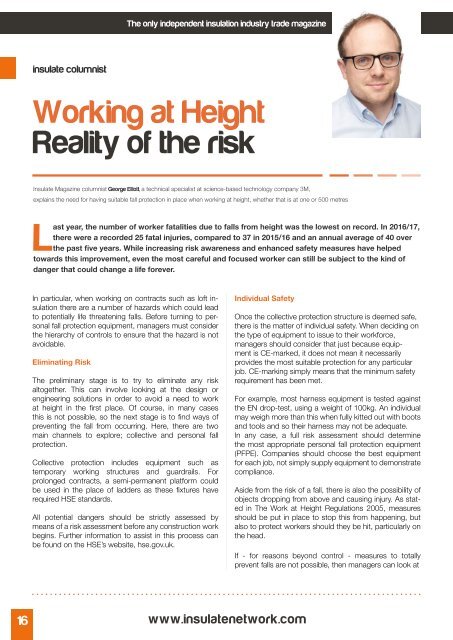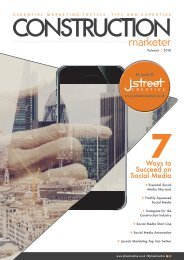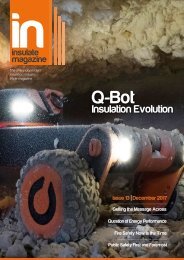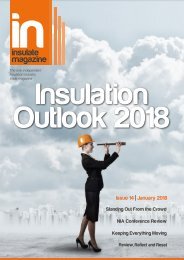Insulate Magazine Issue 12 - November 2017
The 1st Birthday issue of Insulate magazine titled "Round 12 with Recticel" features an exclusive interview with Recticel's commercial Director Kevin Bohea. If that wasn't enough we have a great exclusive inside the BBA, featuring an interview with BBA Chef Executive Richard Beale.
The 1st Birthday issue of Insulate magazine titled "Round 12 with Recticel" features an exclusive interview with Recticel's commercial Director Kevin Bohea. If that wasn't enough we have a great exclusive inside the BBA, featuring an interview with BBA Chef Executive Richard Beale.
You also want an ePaper? Increase the reach of your titles
YUMPU automatically turns print PDFs into web optimized ePapers that Google loves.
The only independent insulation industry trade magazine<br />
insulate columnist<br />
Working at Height<br />
Reality of the risk<br />
<strong>Insulate</strong> <strong>Magazine</strong> columnist George Elliott, a technical specialist at science-based technology company 3M,<br />
explains the need for having suitable fall protection in place when working at height, whether that is at one or 500 metres<br />
Last year, the number of worker fatalities due to falls from height was the lowest on record. In 2016/17,<br />
there were a recorded 25 fatal injuries, compared to 37 in 2015/16 and an annual average of 40 over<br />
the past five years. While increasing risk awareness and enhanced safety measures have helped<br />
towards this improvement, even the most careful and focused worker can still be subject to the kind of<br />
danger that could change a life forever.<br />
In particular, when working on contracts such as loft insulation<br />
there are a number of hazards which could lead<br />
to potentially life threatening falls. Before turning to personal<br />
fall protection equipment, managers must consider<br />
the hierarchy of controls to ensure that the hazard is not<br />
avoidable.<br />
Eliminating Risk<br />
The preliminary stage is to try to eliminate any risk<br />
altogether. This can involve looking at the design or<br />
engineering solutions in order to avoid a need to work<br />
at height in the first place. Of course, in many cases<br />
this is not possible, so the next stage is to find ways of<br />
preventing the fall from occurring. Here, there are two<br />
main channels to explore; collective and personal fall<br />
protection.<br />
Collective protection includes equipment such as<br />
temporary working structures and guardrails. For<br />
prolonged contracts, a semi-permanent platform could<br />
be used in the place of ladders as these fixtures have<br />
required HSE standards.<br />
All potential dangers should be strictly assessed by<br />
means of a risk assessment before any construction work<br />
begins. Further information to assist in this process can<br />
be found on the HSE’s website, hse.gov.uk.<br />
Individual Safety<br />
Once the collective protection structure is deemed safe,<br />
there is the matter of individual safety. When deciding on<br />
the type of equipment to issue to their workforce,<br />
managers should consider that just because equipment<br />
is CE-marked, it does not mean it necessarily<br />
provides the most suitable protection for any particular<br />
job. CE-marking simply means that the minimum safety<br />
requirement has been met.<br />
For example, most harness equipment is tested against<br />
the EN drop-test, using a weight of 100kg. An individual<br />
may weigh more than this when fully kitted out with boots<br />
and tools and so their harness may not be adequate.<br />
In any case, a full risk assessment should determine<br />
the most appropriate personal fall protection equipment<br />
(PFPE). Companies should choose the best equipment<br />
for each job, not simply supply equipment to demonstrate<br />
compliance.<br />
Aside from the risk of a fall, there is also the possibility of<br />
objects dropping from above and causing injury. As stated<br />
in The Work at Height Regulations 2005, measures<br />
should be put in place to stop this from happening, but<br />
also to protect workers should they be hit, particularly on<br />
the head.<br />
If - for reasons beyond control - measures to totally<br />
prevent falls are not possible, then managers can look at<br />
16<br />
www.insulatenetwork.com













